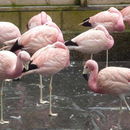Biology
(
Inglês
)
fornecido por Arkive
Flamingos are long-lived, reaching up to 50 years old. They breed together in colonies, between December and February (2). Usually only a single egg is laid, and breeding success appears to be low (2). Flocks of flamingos are a stunning site and may be partly nomadic, searching for their inconsistent food supply of algae (2).
Conservation
(
Inglês
)
fornecido por Arkive
The Andean flamingo is protected by its listing on Appendix II of the Convention on International Trade in Endangered Species (CITES) (3) and Appendix I of the Convention on Migratory Species (CMS) (4). A self-sustaining captive population of Andean flamingos exists at the Wildfowl and Wetlands Trust at Slimbridge in the UK (5). These birds provide useful research subjects into behavioural aspects of this species. Flamingos are an emotive bird and as such can act as important flagship species for the conservation of the world's highly delicate wetland ecosystems (5).
Description
(
Inglês
)
fornecido por Arkive
The Andean flamingo possesses the typical elegant flamingo body shape, with long legs and a long, curved neck (5). The body is pale pink, with bright upperparts and a noticeable patch of black on the wing (2). The legs are yellow and the large, curved bill is yellow and black (2). Young birds are grey in colour before they develop the pink adult plumage (2).
Habitat
(
Inglês
)
fornecido por Arkive
Inhabits salt and alkaline lakes at altitudes of between 2,300 – 4,500 metres above sea level (2).
Range
(
Inglês
)
fornecido por Arkive
Found in mountainous areas of Peru, Chile, Bolivia and Argentina (2).
Status
(
Inglês
)
fornecido por Arkive
Classified as Vulnerable (VU – A1acd+2bcd) on the IUCN Red List 2002 (1). Listed on Appendix II of CITES (3), and Appendix I of the Convention on Migratory Species (CMS or Bonn Convention) (4).
Threats
(
Inglês
)
fornecido por Arkive
It is estimated that the population of Andean flamingos has declined by as much as 24% since the mid-1980s (2). In the mid-20th century the collection of eggs was widespread and thousands were collected annually, with devastating results (2). Habitat deterioration in the form of mining activities and falling water levels, due to drought, have also played a part in the decline of this species (2).

